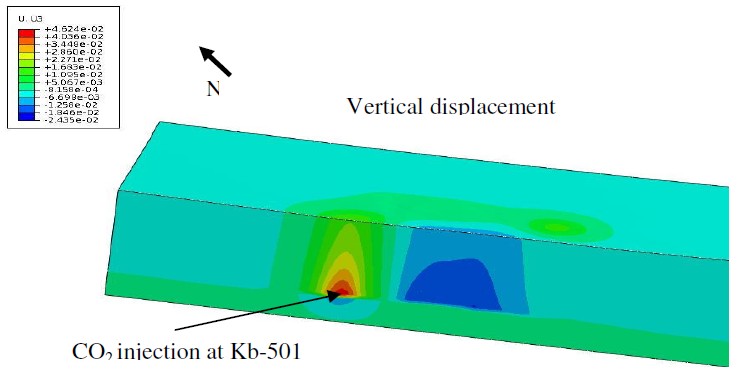2011
Submitted to 45th U.S. Rock Mechanics /Geomechanics Symposium.
Baroni, A. Estublier, J-P. Deflandre and J-M. Daniel (IFP Energies nouvelles)
CO2 storage in geological formations such as deep saline aquifers or depleted oil and gas
reservoirs constitutes the Carbon Capture and Storage (CCS) option to fight against global
warming. In this context, BP, STATOIL and SONATRACH started the In Salah Joint
Venture to manage on a series of fields the CO2 produced -and captured to fit with the
exportation concentration threshold- by re-injecting it in the northern part of the aquifer of the
Krechba gas field. The injection started in August 2004 and to date up to 3 million tonnes of
produced CO2 have been re-injected -17 million tonnes being scheduled at least.
In the frame of the CO2ReMoVe European project, IFP Energies nouvelles and his partners
work at developing tools and methodologies to simulate the CO2 migration within the
reservoir and the resulting site behaviour by working on a series of pilot sites (including
Krechba). The final objective of this project is to be able to model the short term behaviour of
the site and to predict its long term at the scale of the storage complex in order to assess the
storage integrity and its long term performance.
This paper presents the results of a joint 3D fluid flow and geomechanical modelling,
focussing on the geomechanical aspect. An extended structural geomodel has been developed
to simulate the site geomechanical behaviour up to the surface. The pressure field is computed
using a dual-media reservoir model and is extracted at different time to load the
geomechanical model. 3D fluid flow modelling is constrained by history matching (on both
natural gas production data and CO2 injection ones) while also considering an unexpected
CO2 breakthrough at an old appraisal well (occurring between August 2006 and June 2007). A
poro-elastic approach is used to quantify effective stress redistribution and ground
deformation associated with reservoir pressure evolution (Figure 1). Results of the
comparison of observed surface displacement data (~20 mm using InSAR satellite imaging at
end of January 2009) with the simulated ones (~15mm at same date) are analyzed versus time
in order to improve the constitutive law. The success of this approached is demonstrated by a
good fit of the modelling results together with the observed displacement magnitude and
surface extension (uplift and subsidence zones respectively green and blue at ground surface
in Figure 1).

Figure 1: Section cut of vertical displacements resulting from reservoir pressure evolution at
Krechba after ~5.5 years of injection (January 2009 ).
To download the abstract click
here


